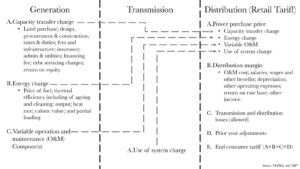On Monday, the Central Power Purchasing Agency (CPPA) — the representative body for the ex-WAPDA distribution companies (DISCOs) — lodged a request for a back-breaking fuel cost adjustment (FCA) of Rs 3.54 per unit. The CPPA contended that consumers had been charged a reference fuel cost of Rs 7.89 per unit in the month of October, whereas the actual cost had escalated to Rs 8.4 per unit. The proposed FCA, if approved, would be the highest for the calendar year of 2023.
While it remains a mystery as to what the final FCA that NEPRA will sanction — especially considering its history of granting final FCAs lower than those requested by the CPPA — the question that begs to be asked is: why is the FCA for October exorbitantly higher than the preceding months? “The actual power generation during October 2023 was a significant 17% lower than the reference generation. This decrease in generation will inevitably inflate the capacity charges for the second quarter’s tariff adjustments of FY24,” explains Rao Aamir Ali, the Deputy Head of Research at Arif Habib. Furthermore, Ali underscores that the FCA will be reflected in January’s consumer price index calculations, thereby impacting inflation.

The National Electric Power Regulatory Authority (NEPRA) has scheduled a hearing for the request on the 29th of November. Once a verdict is reached, the FCA will be levied on units of electricity consumed in October, against the meter readings recorded throughout November, and will eventually be billed to customers in December.
One might wonder about the delay in applying the charge. “The adjustments are made one month later, in the new bills after NEPRA’s approval,” explains Afia Malik, a Senior Researcher at PIDE. As for the lag for this specific charge, Malik attributes it to “administrative hurdles”. “For September’s FCA, CPPA applied for a hearing on October 13, and the hearing was then conducted on November 1,” Malik adds.”
Now that we’ve covered the headlines, the question many might ask is: what even are fuel charge adjustments? Furthermore, there’s also the aforementioned calendar gymnastics that need to be understood.
The anatomy of our electricity bills, and what is a FCA
We have already delved into the intricacies of an average customer’s electricity bill in a previous article.
Read more: Expensive energy: Everything you need to know to understand your electricity bill
However, let us recapitulate the main points.In adherence to the Nepra Tariff Standard & Procedure Rules (1998), NEPRA sets the tariff for all entities involved in the generation, transmission, and distribution of electricity. Atop the aggregate tariff, an array of charges – an electricity duty, a television licence fee, a sales tax, and an income tax – are levied, culminating in the final cost per unit that the customer is obliged to pay.

The FCA is a constituent of the power purchase price, as part of the energy charge. This factor is a sanctioned adjustment bestowed upon electricity utilities by NEPRA, contingent on the monthly oscillation in fuel prices, generation mix, and volume. As a result, this element may wield both positive and negative impacts. This facet hinges on the fluctuations in prices of fuel utilised to generate electricity and the alterations in generation mix and volume. NEPRA calibrates this variable for each month and transfers these costs to customers in their monthly electricity invoices post its meticulous scrutiny and approval.
NEPRA determines this parameter for all Distribution Companies (DISCOs) across the expanse of Pakistan, inclusive of K-Electric. The computation mechanism for this component is the disparity between the weighted average fuel cost per unit dispatched for the month and the weighted average fuel cost per unit dispatched for the reference month – that is, the final month of the preceding quarter.
The proclamation issued by NEPRA for the application of this factor encapsulates details of the amounts and the months wherein this element is to be applied. For instance, in our scenario, NEPRA’s verdict is to apply this facet of October 2023 in December 2023. There can also be multiple entries for this variable in a consumer’s bill if NEPRA elects to impose part of a month’s factor in a future charge. NEPRA’s rationale for such a decision can oscillate due to a myriad of factors, which it explicates in the corresponding proclamation. The most prevalent reason is that it opts to impose only a fraction of this component in any given month.
The FCA is applicable to all customer categories – residential, industrial, and commercial – with the exception of lifeline consumers. On the flip side, consumers also reap a benefit when the cost of fuel diminishes. For instance, NEPRA sanctioned a negative value for this variable for February’s consumption in April’s invoices. The only customers who do not profit from negative values of this element are lifeline consumers, residential consumers with a consumption of up to 300 units in that month, and agricultural consumers.

























ARE YOU A VICTIM OF CRYPTO SCAMS AND WANT TO GET BACK YOUR STOLEN CRYPTOS!!
Am here to testify the handwork of A Great Verified Hacker ( Mr Morris Gray )Who helped me recover back my lost funds from the hands of scammers who Ripped me off my money and made me helpless, I could not afford to pay my bills after the whole incident, But a friend of mine helped me out by given me the contact info of trusted Recovery Expert, his email: Morris gray 830 @ gmail . com contact him or chat him up on (+1- /607-69 )8-0239 ) and he will help you recover your lost funds If you have been a victim of any binary/ cryptocurrency or online scam, Mobile spy, Mobile Hack contact this Trusted and Verified hacker, He is highly recommendable and was efficient in getting my lost funds back, 11btc of my lost funds was refunded back with his help, He is the Best in Hacking jobs, contact him ( MORRIS GRAY 830 AT) GMAIL (DOT) COM…..!
The only customers who do not profit from negative values of this element are lifeline consumers